“We record everything. Throughout all lifetimes”.
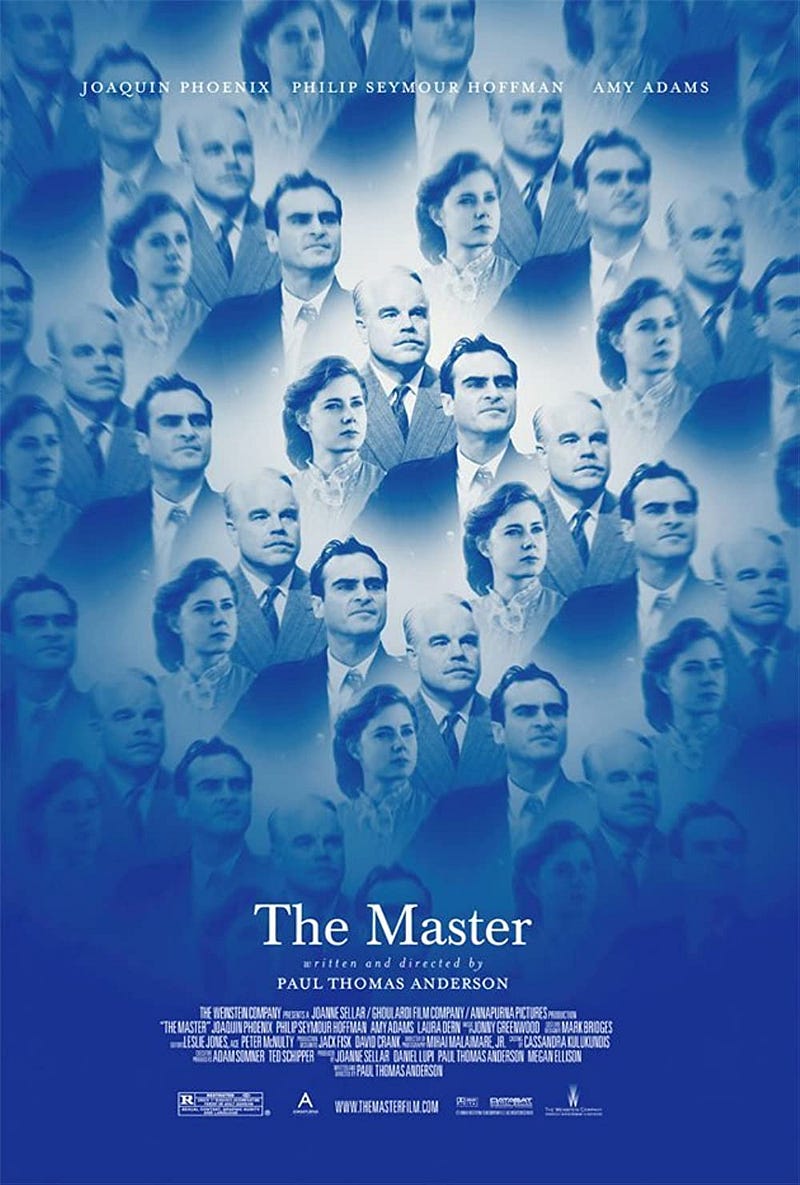
I adore this film on a par with the director’s bizarre and surreal heartbreak of Magnolia 13 years earlier. My adoration follows. Here are some selected quotes from the time of release a decade ago:
“Smart and solidly engrossing, The Master extends Paul Thomas Anderson’s winning streak of challenging films for serious audiences.”
Rotten Tomatoes
“Phoenix, known for immersing himself in Oscar-nominated roles in Gladiator and Walk The Lane, makes Quell frighteningly believable. The Master takes some getting used to. This is a superbly crafted film that’s at times intentionally opaque, as if its creator didn’t want us to see all the way into its heart of darkness."
Los Angeles Times
“It’s also one of the great movies of the year — an ambitious, challenging, and creatively hot-blooded, but cool-toned, project that picks seriously at knotty ideas about American personality, success, rootlessness, master-disciple dynamics, and father-son mutually assured destruction.”
Entertainment Weekly
“the performances by Phoenix and Hoffman are studies in contrast. Phoenix carries himself with a jagged, lurching, simian-like grace, while Hoffman gives Dodd a calm deliberateness. Both actors have rarely been better in the movies. The real Master class here is about acting — and that includes just about everybody else in the film, especially Adams, whose twinkly girl-next-door quality is used here to fine subversive effect.”
Christian Science Monitor
“It is a movie about the lure and folly of greatness that comes as close as anything I’ve seen recently to being a great movie. There will be skeptics, but the cult is already forming. Count me in.”
New York Times
“The Master, the sixth film from the 42-year-old writer-director, affirms his position as the foremost filmmaking talent of his generation. Anderson is a rock star, the artist who knows no limits. “Written, directed, acted, shot, edited, and scored with a bracing vibrancy that restores your faith in film as an art form, The Master is nirvana for movie lovers. Anderson mixes sounds and images into a dark, dazzling music that is all his own.” He would later call the film the Best Film of 2012".
Rolling Stone
“In a film overflowing with qualities, but also brimming with puzzlements, two things stand out: the extraordinary command of cinematic technique, which alone is nearly enough to keep a connoisseur on the edge of his seat the entire time, and the tremendous portrayals by Joaquin Phoenix and Philip Seymour Hoffman of two entirely antithetical men, one an unlettered drifter without a clue, the other an intellectual charlatan who claims to have all the answers. They become greatly important to each other and yet, in the end, have an oddly negligible mutual effect. The magisterial style, eerie mood and forbidding central characters echo Anderson’s previous film, There Will Be Blood, a kinship furthered by another bold and discordant score by Jonny Greenwood.”
The Hollywood Reporter
“fabulously well-acted and crafted, but when I reach for it, my hand closes on air. It has rich material and isn’t clear what it thinks about it. It has two performances of Oscar caliber, but do they connect?”
Roger Ebert
“The Master is Paul Thomas Anderson with the edges sanded off, the best bits shorn down to nubs.”
Slant Magazine
“Call The Master whatever you want, but lobotomized catatonia from what I call the New Hacks can never take the place of well-made narrative films about real people that tell profound stories for a broader and more sophisticated audience. Fads come and go, but, as Walter Kerr used to say, ‘I’ll yell tripe whenever tripe is served.’”
New York Observer
Paul Thomas Anderson — An appreciation
My first ever film blog! Sydney, Boogie Nights, Magnolia, Punch Drunk Love, There Will Be Blood and The Master.medium.com
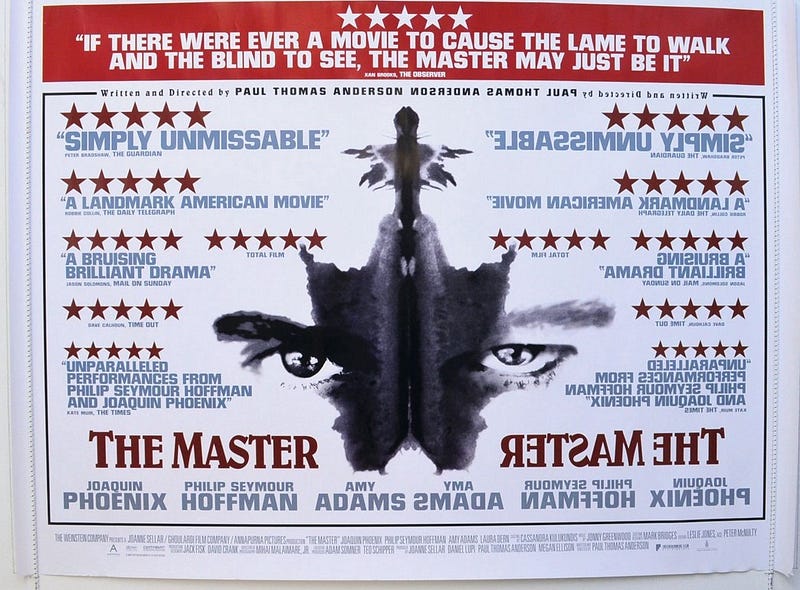
“We record everything. Throughout all lifetimes”.
To say it’s been five long years since There Will be Blood and that I have been eagerly awaiting this release since it was first mooted in 2009 would be an understatement. Add in to the mix a story loosely based on the beginnings of Scientology and it’s founder L Ron Hubbard, plus the supreme acting talents of Philip Seymour Hoffman and Joaquin Phoenix and it’s been a slow three years to arrive. But well worth the wait as Paul Thomas Anderson has again produced a truly wonderful film. Again Paul both wrote the screenplay and directed as well as producing but the first major change to note from his previous films is the choice of Cinematographer, with Mihai Malaimare replacing long term collaborative partner Robert Elswit. However this change doesn’t transmit in any way to the screen as you’re immediately struck by how vibrant, pinpoint sharp and colourful this film is despite it being slightly de-saturated of colour to reflect the 1940/50’s time setting.
The vibrancy of the picture is a joy, as are the multitude of settings photographed so well by Cinematographer Mihai Malaimare, bringing to life numerous beach scenes, ocean views and desert plains with a typically long lens but equally quite brilliant each time. Inside shots are framed and lit brilliantly, often in a cramped room of a house or ship, with Director Paul Thomas Anderson reinforcing the claustrophobia with tight angled shots and a gently rolling camera to encompass and capture the scene. At this early stage, all of Amy Wells (Set Design), David Crank and Jack Fisk (Production Design) and Mark Bridges (Costume Design) deserve immense credit, as does Jonny Greenwood for another haunting, jaunty and eclectic film score and overall original music.
A biased fan of Radiohead I may be, however Jonny Greenwood’s musical score is again sublime and follows on from his success with There Will be Blood. The score here is very similar in tone to that of There Will be Blood with climbing operatic pieces mixed with orchestral pieces that accompany the film perfectly but in an odd and sporadic way. There are eleven original pieces of music from Jonny Greenwood with stand out pieces such as “Overtones”, “Time Hole” and “Alethia” perfectly encapsulating the characters fractured minds as they bump and pop along in the background of the film, rising and falling gently along with the narrative.
The musical tracks included are also odd and quirky choices but fit the film perfectly such as stand outs “Get Thee Behind Me Satan” by Ella Fitzgerald, “No Other Love” by Jo Stafford and “Changing Partners” by Helen Forrest over the closing credits. There are also three superb tracks from the actors themselves, with Philip Seymour Hoffman singing “Slow Boat to China” in a heart breaking scene as well as “I’ll Go No More A-Roving” in a bizarre and surreal scene! But the stand out belongs to actress Madison Beaty with “Don’t Sit Under the Apple Tree (With Anyone Else But Me)”. Many but not all of these feature on the CD soundtrack that accompanies this film and which is thoroughly recommended yet again.
The film itself is set between the end of World War II and the early 1950’s and covers roughly a five year period. The opening twenty minutes cover this time period quickly to bring us both up to date with the timeline and to fill in a compelling back story to “Freddie Quell” (Joaquin Phoenix). As with the beginning of There Will be Blood, this film also starts with minimal dialogue but supreme cinematography of a lapping tide at a beach with a naval platoon awaiting either orders or the end of the War. Freddie’s personal problems are immediately obvious in the first three or four minutes of this 144 minute classic as he’s immediately portrayed as an outsider and a loner with a strangely awkward gait and style.
His first words depict how to get rid of a sexual disease to a fellow sailor and then awkwardly he engages sexually with a woman figure carved in the sand to which he becomes too sexually excited and to the bemusement of his fellow sailors he masturbates into the ocean to relieve himself. Undergoing a medical to leave the Navy he continually references sex but the overall picture painted of Freddie is of an awkward and unsure outsider who wants to be accepted, along with his alcoholic “potion” that accompanies his journey from leaving the navy to becoming a cantankerous photographer in a local Mall, to chopping vegetables in a field in California before escaping and stowing away aboard a passing luxury ship. Here he meets “Lancaster Dodd” and “Peggy Dodd” and a legendary film is truly born.
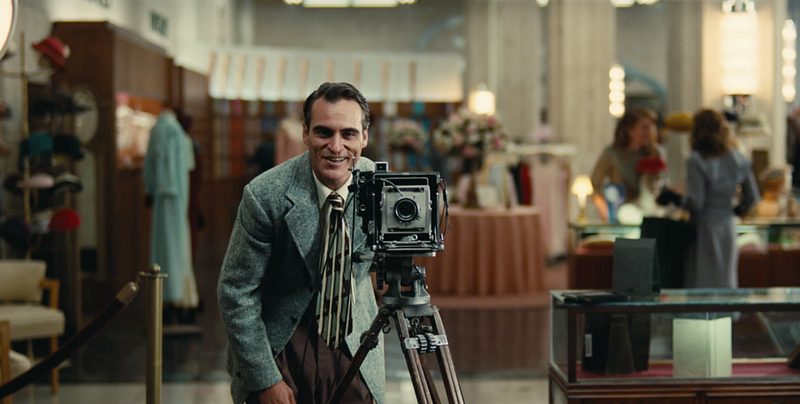
“Freddie Quell” (Joaquin Phoenix) An alcoholic outsider and drifter whose quirks, ticks and nervous tension could be explained as a result of Post Traumatic Stress Disorder, or shell shock in the much simpler vernacular of the day. He is physically and mentally shattered into pieces. His physical ticks are evident through a lazy eye and speaking through one side of his mouth with a sometimes unintelligible drawl. His gait is awkward into an almost contortion of his body from the waist down and gives a constant appearance of being unable to stand up straight and move without the appearance of pain.
Mentally, Freddie’s obvious alcoholism is a constant problem and his hip flask is repeatedly on show as he tops this up with his “potion” but equally evident is his inappropriate bouts of overt sexuality and he’s unable to control a temper that swings violently out of control. In many ways Freddie is an open book for all of this and more and it’s to Joaquin Phoenix’s great credit as his performance from start to finish is exactly that, a performance, of obvious personality traits, ticks, compulsions and obsessions. His first session of “Informal Processing” (more of which later) is apt and confirms the openness we see as an audience to his failings. As he answers the questions during the processing I immediately contradicted every answer as his frailties are very much in evidence immediately he is on screen.
This is not to be seen as a negative in any way as this is purely intentional and part of Freddie’s journey in the film. Despite The Master moniker for the film, this is Freddie’s film and so expertly brought to life by a much maligned, but absolutely brilliant character actor in Joaquin Phoenix. A career defining performance and well worthy of his Best Actor nomination at the 2013 Oscars.
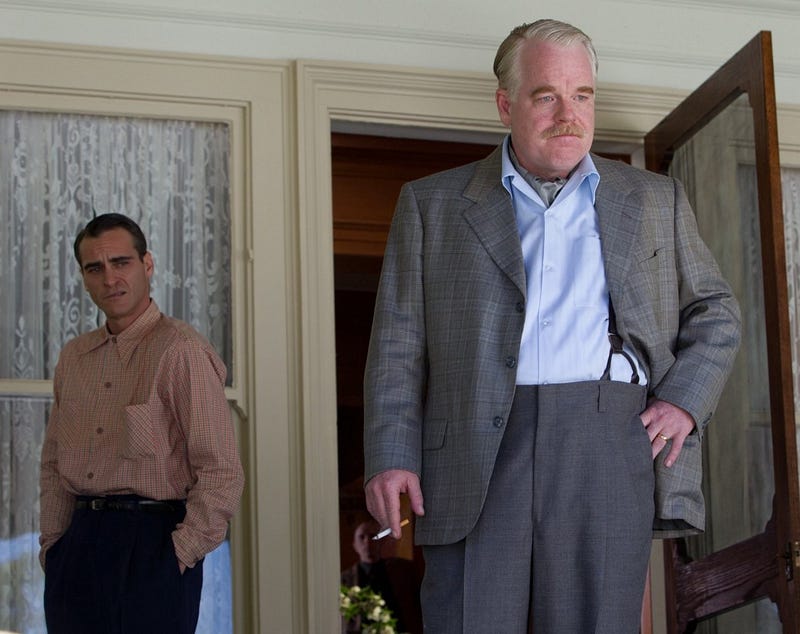
“Lancaster Dodd” (Philip Seymour Hoffman) Known throughout as “Master” by everyone he comes into contact with but not in a totally slavishly devoted way, more out of genuine respect for a pioneer figure who is seemingly perma smiled and loved by everyone that surrounds him. Jovial and very much the centre of attention with a hyper positive attitude, his performances and lectures always reference “past lives” and “processing” as well as constantly railing against a humanity that he is sees as asleep to possibilities outside of their comfort zone. “Man is Asleep” is a telling reference to the “Cause” he promotes, of past lives continually living on through the soul and spirit to present lives and beyond.
Fiercely loyal to his family and his gathering band of devotees as well as the Cause’s message, Dodd’s duality is subtly unravelled but never more evident than when his message and teachings are challenged. However there is far more than this as the film progresses. Yet another wonderful character performance from Philip Seymour Hoffman in a Paul Thomas Anderson film, their fifth collaboration in six films, and a very well deserved Oscar nomination for Best Supporting Actor at the 2013 Oscars.
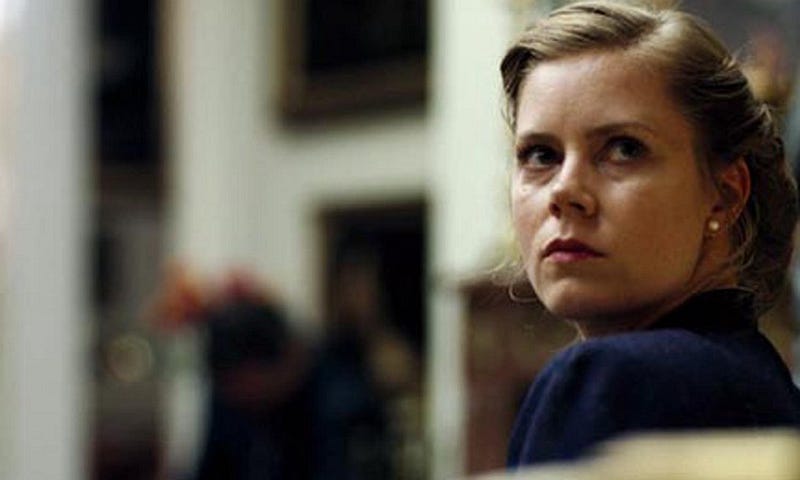
“Peggy Dodd” (Amy Adams) A thunderous and career defining performance from Amy Adams and as with her esteemed co-stars, fully deserving of her Oscar nomination in 2013 for Best Supporting Actress. With minimal dialogue, it’s the touches, glances and often cold barren stares that make this performance so thunderous and my immediate take is that Peggy is the real driving force behind the “Cause” and very definitely the power behind the throne. Always seemingly looking at (through?) and perhaps constantly and silently judging Freddie, she is vociferous to outsiders and non-believers but in a subtle and nuanced way. She reserves her vitriol for Lancaster and their private time together but in public is a silent, judging rock for her husband.
As the film develops so too does Peggy’s silent menace and never more aptly shown than when Lancaster is challenged over the veracity of the cause. As Lancaster becomes angry and flustered Peggy is silently raging at the challenger, firstly in soft out of focus just below her husband who dominates the shot but two quick cuts later display her rage and apoplexy at the cheek of anyone to question their beliefs. There is one brief scene between husband and wife that spoilers prevent me from disclosing but when you see it you will understand the definite power balance in play. It’s a wonderfully surreal scene that says so much. The joy of Adams’ performance is the subtlety on display and against two astounding performances above, eclipses these to become the true stand out star. A brilliant and mesmerising performance.
Across several narrative strands and locations there are superb supporting roles throughout notably, Amber Childers as perma smiling daughter “Elizabeth Dodd” and Jesse Plemons plays fellow sibling “Val Dodd” brilliantly with purposely very little dialogue to work with. Rami Malek is excellent as Lancaster’s new Son-in-Law “Clark” and Madison Beaty plays “Doris” with a gentle beauty that is perfectly encapsulated when she sings “Don’t Sit Under the Apple Tree”. Laura Dern plays a socialite/supporter of the Cause well as “Helen Sullivan” and finally Kevin J O’Connor returns from a similarly vague role in There Will be Blood with another here as “Bill William”. There are many more cameo and supporting roles as we weave between Freddie’s leaving of the Navy to following the Cause and following Lancaster Dodd as he travels from city to city to promote his faith, his writings and his experiences.
Two brief scenes follow, one encapsulates Freddie’s early sexual desperation and a burgeoning alcohol problem, the other is a thunderous piece of cinema. Each scene is vastly different to the other but an ideal taster for Freddie’s journey and wonderful examples of the Director’s eye for cinematic scenes of real beauty.
“Martha the Salesgirl” (Amy Ferguson) is introduced in a beautiful, gentle and almost balletic continuous camera shot as she walks the floor of the Department Store selling the dress she’s wearing. Always smiling but equally always looking in Freddie’s direction as she continues her gentle dance around the floor, the scene is accompanied by the sublime “Get Thee Behind Me Satan” by Ella Fitzgerald. “You have a break coming?” asks Freddie.
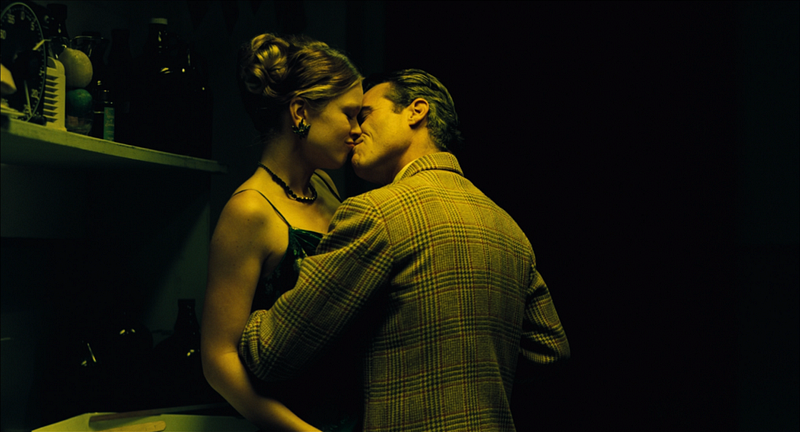
As “Get Thee Behind Me Satan” continues gently in the background there is a brief interlude scene whereby Freddie makes his “potion” and this is quickly cut to Martha sampling his concoction. Freddie is now drunk and weaving as the pair stand together in his yellow tinged photography darkroom “Taste Good?” he asks before forcibly kissing Martha and breaking out into his manic laughter. Martha plays along with the sexual tension, teasing Freddie with “What else do you want to see, these?” as she reveals her breasts. Before she can do so, Freddie’s immediate “Yes” perfectly depicts his sexual desperation. Playing with Martha’s breasts, they kiss passionately again before Freddie regains a little composure to ask Martha for a date.
A brilliant cameo appearance from Amy Ferguson and Joaquin Phoenix sets the tone again for Freddie’s coming descent.
Next, following Dodd’s arrest, Freddie’s violent reaction leads him to be arrested too and they are both housed in adjoining jail cells. Freddie’s arrival sees a violent continuation of his frustration as he continually head butts a bed and a cell wall before kicking the toilet to pieces in abject anger and rage. Dodd stands in his cell completely impassively throughout watching his friend’s tortuous and violent outburst before he finally comments “Your fear of capture and imprisonment is an implant from millions of years ago. This battle has been with you since before you know it. This is not new. This is not you”. Freddie continues to reacts angrily to Dodd’s calming words and with a camera angle to between the two cells their continuing exchange is captured, of Dodd preaching to his friend and of Freddie, prowling his cell like a caged lion. As the camera reverts back to Dodd, he continues “You are asleep. Your spirit was free. Moving from body to the next body. Free. Free for a moment. Then it was captured by an Invader force bent on turning you to the darkest where you’ve been implanted with a push/pull mechanism that keeps you fearful of authority and destructive. We are in the middle of a battle that is a trillion years in the making and is bigger than the both of us”.
An intense face to face argument ensues:
Freddie: “Your fucking family hates you. Your son hates you”
Dodd: “Who fucking likes you, except for me?”
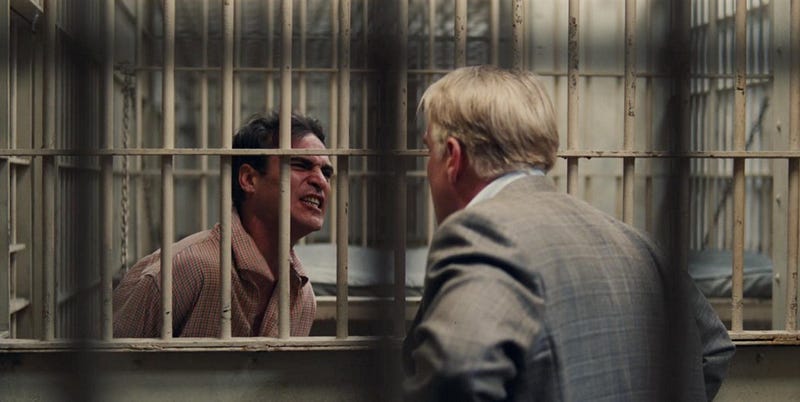
The scene ends in a surreal and bizarre fashion however not before Dodd continually and tellingly reinforces to Freddie that he is alone with no friends to call on and that he alone is his only friend who believes in him yet still does not want to see him ever again. “We’re done. You’re a drunk. We’re done”.
This is just one example of numerous thunderous performances from Joaquin Phoenix and Philip Seymour Hoffman in their joint scenes together. There are six in all whereby they are the only two characters in the scene, plus a heart breaking telephone conversation. Each scene from their initial meeting as Freddie is caught as a stowaway to their telephone conversation adds more and more layers to a fractured and seemingly difficult friendship that is ultimately far more than a simple friendship.
I know a little of Scientology as a religion, it’s teachings and indeed it’s spiritual Leader L Ron Hubbard, but I’ll leave discussions for people far more learned than I. Suffice to say the comparisons and references of “The Cause”, “Past Lives” and “Processing” are obvious nods to this as is the ever smiling and charismatic Leader Lancaster Dodd. Forever known simply as Master he is the Master of all he surveys and always the centre of attention. The Processing aspect is heavily covered and for the uninitiated this appears to be a form of regression, but not to your childhood but to past lives lived and experiences gained for this life. A perpetual soul and spirit living on from body to body, life to life. There are also numerous references from Dodd to the comparisons between humans and animals and the distinctions between the two and our advancement as humans over the animal kingdom.
But what captivated me, and always captivates me, are the three central performances from Amy Adams, Joaquin Phoenix and Philip Seymour Hoffman, sublime cinematography from Mihai Malaimare, a musical score from Jonny Greenwood that is awkward and jaunty and all the better for it and a joy of a film from Director Paul Thomas Anderson. Forever criticised for not being able to “end” his previous films, this is an unfair criticism labelled at him but not here. The ending is the weakest part of a brilliant film that captured my imagination from the first minute to the last and is Paul’s sixth utterly astounding cinematic feature. Roll on number seven and hopefully not a five year hiatus in between.
Thanks for reading. Just for larks as always, and always a human reaction rather than spoilers galore. My three most recently published film articles are linked below or there’s well over 200 blog articles (with 400+ individual film reviews) within my archives from which to choose:
“Ed Wood” (1994)
The Best of Tim Burton — Vol 2.medium.com
“The Insider” (1999)
The Best of Michael Mann — Vol 2.medium.com
“Synecdoche, New York” (2008)
In appreciation of Philip Seymour Hoffman.medium.com



Fantastic review. My favorite director.